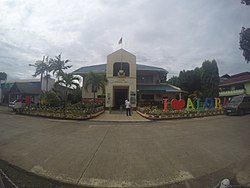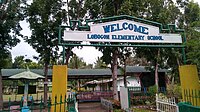Aloran
Aloran | |
|---|---|
| Municipality of Aloran | |
 Municipal hall | |
| Nickname: Heart of MisOcc | |
 Map of Misamis Occidental with Aloran highlighted | |
Location within the Philippines | |
| Coordinates: 8°24′53″N 123°49′22″E / 8.414622°N 123.822781°E | |
| Country | Philippines |
| Region | Northern Mindanao |
| Province | Misamis Occidental |
| District | 1st district |
| Founded | January 1, 1917 |
| Barangays | 38 (see Barangays) |
| Government | |
| • Type | Sangguniang Bayan |
| • mayor of Aloran[*] | Junipher "Insek" A. Roa (PDPLBN) |
| • Vice Mayor | Jimmy R. Regalado (NP) |
| • Representative | Jason P. Almonte (PDPLBN) |
| • Municipal Council | Members |
| • Electorate | 21,158 voters (2022) |
| Area | |
| • Total | 118.06 km2 (45.58 sq mi) |
| Elevation | 50 m (160 ft) |
| Highest elevation | 303 m (994 ft) |
| Lowest elevation | 0 m (0 ft) |
| Population (2020 census)[3] | |
| • Total | 27,934 |
| • Density | 240/km2 (610/sq mi) |
| • Households | 6,958 |
| Economy | |
| • Income class | 4th municipal income class |
| • Poverty incidence | 28.08 |
| • Revenue | ₱ 133.9 million (2020) |
| • Assets | ₱ 239.3 million (2020) |
| • Expenditure | ₱ 118.2 million (2020) |
| • Liabilities | ₱ 55.39 million (2020) |
| Service provider | |
| • Electricity | Misamis Occidental 1 Electric Cooperative (MOELCI 1) |
| Time zone | UTC+8 (PST) |
| ZIP code | 7206 |
| PSGC | |
| IDD : area code | +63 (0)88 |
| Native languages | Subanon Cebuano Tagalog |
| Website | www |
Aloran, officially the Municipality of Aloran (Cebuano: Lungsod sa Aloran; Tagalog: Bayan ng Aloran), is a 4th class municipality in the province of Misamis Occidental, Philippines. According to the 2020 census, it has a population of 27,934 people.[3]
History
[edit]Through Executive Order No. 67, issued by Governor-General Francis Burton Harrison on September 30, 1916, four barrios in Oroquieta were separated and organized into an independent municipality named Aloran, with one of them having the same name as its seat of government. The order became effective at the beginning of 1917.[5]
Geography
[edit]Barangay
[edit]Aloran is politically subdivided into 38 barangays. Each barangay consists of puroks while some have sitios.
- Balintonga
- Banisilon
- Burgos
- Calube
- Caputol
- Casusan
- Conat
- Culpan
- Dalisay (poblacion)
- Dullan
- Ibabao (poblacion)
- Tubod
- Labo
- Lawa-an
- Lobogon
- Lumbayao
- Makawa
- Manamong
- Matipaz
- Maular
- Mitazan
- Mohon
- Monterico
- Nabuna
- Palayan
- Pelong
- Ospital (poblacion)
- Roxas
- San Pedro
- Santa Ana
- Sinampongan
- Taguanao
- Tawi-tawi
- Toril
- Tuburan
- Zamora
- Macubon (Sina-ad)
- Tugaya
Climate
[edit]| Climate data for Aloran, Misamis Occidental | |||||||||||||
|---|---|---|---|---|---|---|---|---|---|---|---|---|---|
| Month | Jan | Feb | Mar | Apr | May | Jun | Jul | Aug | Sep | Oct | Nov | Dec | Year |
| Mean daily maximum °C (°F) | 28 (82) |
28 (82) |
29 (84) |
31 (88) |
31 (88) |
30 (86) |
30 (86) |
30 (86) |
30 (86) |
30 (86) |
29 (84) |
28 (82) |
30 (85) |
| Mean daily minimum °C (°F) | 23 (73) |
23 (73) |
23 (73) |
23 (73) |
24 (75) |
24 (75) |
24 (75) |
24 (75) |
24 (75) |
24 (75) |
24 (75) |
23 (73) |
24 (74) |
| Average precipitation mm (inches) | 69 (2.7) |
44 (1.7) |
37 (1.5) |
29 (1.1) |
87 (3.4) |
137 (5.4) |
131 (5.2) |
141 (5.6) |
143 (5.6) |
134 (5.3) |
68 (2.7) |
53 (2.1) |
1,073 (42.3) |
| Average rainy days | 9.9 | 7.6 | 7.4 | 8.1 | 21.6 | 26.5 | 26.4 | 26.6 | 25.8 | 24.3 | 15.1 | 10.4 | 209.7 |
| Source: Meteoblue[6] | |||||||||||||
Demographics
[edit]
|
| ||||||||||||||||||||||||||||||||||||||||||||||||
| Source: Philippine Statistics Authority[7][8][9][10] | |||||||||||||||||||||||||||||||||||||||||||||||||
In the 2020 census, the population of Aloran, Misamis Occidental, was 27,934 people,[3] with a density of 240 inhabitants per square kilometre or 620 inhabitants per square mile.
Economy
[edit]Poverty incidence of Aloran
10
20
30
40
50
2006
39.10 2009
42.69 2012
39.58 2015
34.44 2018
23.51 2021
28.08 Source: Philippine Statistics Authority[11][12][13][14][15][16][17][18] |
Festival
[edit]"Bunga Dag Tabinal Festival" is held every September 21.
Gallery
[edit]-
Municipal Plaza and Koi Pond
-
Don Mariano Marcos Farmers' Training Center
-
Rural Health Unit
-
Lobogon Elementary School
References
[edit]- ^ Municipality of Aloran | (DILG)
- ^ "2015 Census of Population, Report No. 3 – Population, Land Area, and Population Density" (PDF). Philippine Statistics Authority. Quezon City, Philippines. August 2016. ISSN 0117-1453. Archived (PDF) from the original on May 25, 2021. Retrieved July 16, 2021.
- ^ a b c Census of Population (2020). "Region X (Northern Mindanao)". Total Population by Province, City, Municipality and Barangay. Philippine Statistics Authority. Retrieved 8 July 2021.
- ^ "PSA Releases the 2021 City and Municipal Level Poverty Estimates". Philippine Statistics Authority. 2 April 2024. Retrieved 28 April 2024.
- ^ Executive orders and proclamations (1916). Manila: Bureau of Printing. 1917. pp. 142–144. Retrieved March 14, 2024 – via Google Books.
- ^ "Aloran: Average Temperatures and Rainfall". Meteoblue. Retrieved 29 April 2020.
- ^ Census of Population (2015). "Region X (Northern Mindanao)". Total Population by Province, City, Municipality and Barangay. Philippine Statistics Authority. Retrieved 20 June 2016.
- ^ Census of Population and Housing (2010). "Region X (Northern Mindanao)" (PDF). Total Population by Province, City, Municipality and Barangay. National Statistics Office. Retrieved 29 June 2016.
- ^ Censuses of Population (1903–2007). "Region X (Northern Mindanao)". Table 1. Population Enumerated in Various Censuses by Province/Highly Urbanized City: 1903 to 2007. National Statistics Office.
- ^ "Province of Misamis Occidental". Municipality Population Data. Local Water Utilities Administration Research Division. Retrieved 17 December 2016.
- ^ "Poverty incidence (PI):". Philippine Statistics Authority. Retrieved December 28, 2020.
- ^ "Estimation of Local Poverty in the Philippines" (PDF). Philippine Statistics Authority. 29 November 2005.
- ^ "2003 City and Municipal Level Poverty Estimates" (PDF). Philippine Statistics Authority. 23 March 2009.
- ^ "City and Municipal Level Poverty Estimates; 2006 and 2009" (PDF). Philippine Statistics Authority. 3 August 2012.
- ^ "2012 Municipal and City Level Poverty Estimates" (PDF). Philippine Statistics Authority. 31 May 2016.
- ^ "Municipal and City Level Small Area Poverty Estimates; 2009, 2012 and 2015". Philippine Statistics Authority. 10 July 2019.
- ^ "PSA Releases the 2018 Municipal and City Level Poverty Estimates". Philippine Statistics Authority. 15 December 2021. Retrieved 22 January 2022.
- ^ "PSA Releases the 2021 City and Municipal Level Poverty Estimates". Philippine Statistics Authority. 2 April 2024. Retrieved 28 April 2024.








